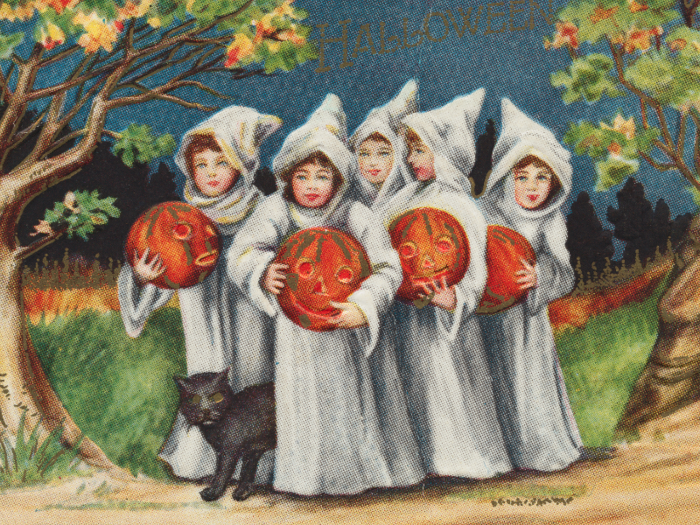
This tradition was called "souling." It took place during Samhain, the night before the Celtic New Year, when it was believed that the dead roamed the Earth — and only community prayer could save their souls.
Source: Today I Found Out

During this era of pre-Halloween, trick-or-treaters got a little more adventurous. Instead of just promising prayer, they started singing songs, telling jokes, or staging doorstep performances for their treats. The tradition came to be known as mumming.
Source: Time, The History Channel

These tricks involved throwing apple peels or cracking eggs into a bowl in hopes that their future husband's initials would appear. One even had them looking in the mirror in a candlelit room to see a reflection of their beloved's face.
Source: The History Channel, Mental Floss

It was made with nutmeg, ginger, cinnamon, and raisins, and stamped with a cross on top that symbolized a soul being saved from Purgatory. The earliest soul cakes were placed outside homes to prevent mischievous spirits from playing tricks on All Souls' Day, but eventually, the sweet buns were baked for real-life trick-or-treaters.
Source: The History Channel, NPR

Pomona was associated with apples, and apples were in turn considered a symbol of love and fertility. The significance of this fruit likely evolved into the modern-day Halloween tradition of bobbing for apples.
Source: PBS, The History Channel

Ancient Celts would hide behind masks or paint their faces black and wear old clothing so the ghosts wouldn't recognize and taunt them. Later, when the holiday morphed into All Hallow's Eve, people began dressing up as angels, saints, and devils as they roamed the neighborhood bargaining for treats.
Source: The History Channel

Some American colonists had been celebrating Guy Fawkes Day around the same time of year, but souling and guising quickly took its place. The mass commercialization of Halloween, however, didn't take hold for another 50 years or so.
Source: The History Channel

In the 1920s, souling was replaced with pranking, and the shenanigans only got worse the following decade, when the Great Depression hit. Youth-fueled mischief devolved into flat-out vandalism and violence, as overturned cars, trashed houses, and even harassment and assault became common.
Source: The History Channel

This gave rise to organized community get-togethers, activities, and parades in the 1920s, which later morphed into Halloween parties in the 1950s.
Source: The History Channel

Parents borrowed from the tradition of souling and now offered up their homes as welcoming places for millions of young baby boomers to receive snacks — a sort of friendly bribe in exchange for good behavior and no more trouble-making.
Source: The History Channel, PBS

At first, costumed kids went door to door for things like coins, toys, nuts, and fruit. But by the 1950s, candy manufacturers saw an opportunity to seize upon the youth-centric holiday and took it. Halloween candy campaigns emerged in full force, parents saw a cost-effective treat that was easy to distribute, and the rest is history.
Source: The Atlantic

Although it seems contradictory — as houses decorated with cobwebs and ghouls are just the kind of spooky stuff parents were trying to ban — they felt it was another effective way to distract restless young men during the Great Depression. Families would go all-out with horrifying Halloween decor and booby traps, then invite trick-or-treaters in for a dose of contained mischief.
Source: Smithsonian Magazine, The History Channel

Halloween cookie cutters grew popular for making biscuits shaped like witches and pumpkins. Cupcakes became another holiday favorite and would often be topped with icing in orange and black, which represented harvest and death and were fast becoming Halloween's official colors.
Source: PBS

It's estimated that more than 160 million Americans will buy Halloween candy this year for neighborhood kids — and spend a whopping $2.6 billion on it. Some of the most popular modern-day Halloween candy includes Reese's peanut butter cups, M&Ms, and Milk Duds. Soul cakes? Never heard of 'em.
Source: The Candy Industry, The Balance

Mass-produced costumes started to emerge in the early 20th century, when modern-day Halloween really took root. Characters from cartoons, books, and other pop culture mediums were in high demand — and by the time World War II ended, they became much more affordable.
Source: Insider, The Balance

While pop culture costumes are still a mainstay, the more traditionally spooky get-ups are still statistically the most coveted across the country. Witches, pirates, vampires, zombies, and ghosts reign supreme, but superheroes are consistently popular choices — especially the Avengers.
Source: Business Insider

In 2018, consumers spent a frightful $9 billion on Halloween, all told.
Source: Business Insider
 Love in the time of elections: Do politics spice up or spoil dating in India?
Love in the time of elections: Do politics spice up or spoil dating in India?
 Samsung Galaxy S24 Plus review – the best smartphone in the S24 lineup
Samsung Galaxy S24 Plus review – the best smartphone in the S24 lineup
 Household savings dip over Rs 9 lakh cr in 3 years to Rs 14.16 lakh cr in 2022-23
Household savings dip over Rs 9 lakh cr in 3 years to Rs 14.16 lakh cr in 2022-23

Copyright © 2024. Times Internet Limited. All rights reserved.For reprint rights. Times Syndication Service.